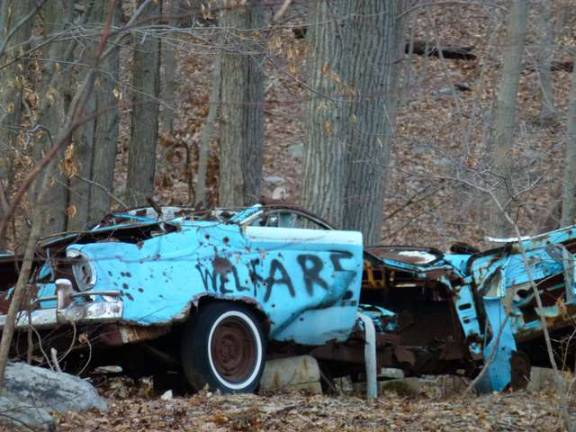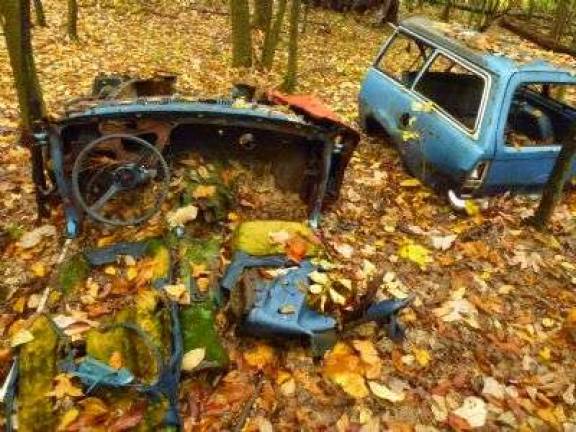A derelict retrospective







Riddled with bullets and covered by vines, rusty vehicles become trailside artifacts
Along the Pioneer Trail, near a spur trail leading to the Delaware River, we spotted a bicycle leaning against a tree. It had a tentative air, as if the rider had just disembarked for a stroll down to the riverbank. I got the unsettling feeling that comes with finding you aren’t alone in the woods. Voices carry a long way through the trees, as do the cracking of twigs and the crunching of dry leaves underfoot. But all we could hear was the rush of wind and river. The bicycle owner must be holding very still, spying on us, perhaps. But we soon realized that the bike had been leaning against that tree for a very long time. The frame was unbent and the colors still bright, but the tires were peeling off in dry-rotted strips, and the rims were planted in the earth. It’s the first step any object must take in becoming an archaeological artifact. Given enough time, things at rest sink into the earth like any scuttled boat. That’s why Troy comes in nine layers. Lean your bike against a tree, come back in a few millennia, and you’ll need more than a bulldozer to get it back.
Halfway up the Smiley Carriageway to Napanoch Point are some abandoned trucks straight out of “The Grapes of Wrath.” They once belonged to the blueberry pickers who migrated every summer to the Shawangunk Ridge, where their old tarpaper shacks still lean against the ledges. One day back in the ‘40s, or ‘50s, a jaunty pickup faced with wooden slats pulled off the road for the last time. Now, vines invade every breach. Saplings sprout through the floorboards. A classmate once said about a crabby old teacher of ours: “She was somebody’s baby once!” And so it was with this truck. Not so long ago it sat gleaming in a showroom while a salesman talked up its many wondrous features: Fully automatic windshield wipers! Foot-regulated air scoop floor ventilators! Automatic door stops! A porcelain knob sticking out from the rusted dash is still bright and pretty.
Some artifacts end up in the woods not with a whimper but with a boom. Small planes hit mountains with unobserved violence all the time. “You can’t fly a plane at 2,500 feet through a 3,000-foot mountain,” said one resident with characteristic Catskills concision after an especially bad smash in the ‘80s. The wide-thrown bits and pieces remain right where they come to rest, chilling reminders of lives lost on the spot. Along a trail near the top of Kaaterskill High Peak are the twisted remains of a Piper aircraft. It would look like the wreckage of a washing machine if not for the big chunk of engine at its center. I feel as if I could hold all the flimsy shards in my palm and crush them like a soda can. Two people died when this plane collided with the mountain one June day in 1987. As I pass the debris field in the remote intimacy of the woods, I express the wish that their spirits have moved on.
Norvin Green State Forest is so studded with cars from the 1950s, it has the effect of a walking tour. You’d almost expect to be handed a numbered brochure. Here’s a fine old Chevy whose carburetor is covered with moss. Over there’s an ancient Ford that looks like it was cut in half with a bread knife. And every car is riddled with bullets, Bonnie and Clyde style. Heavy fenders make satisfying targets. Their steel and glass and leather come from the “they don’t make ‘em like that anymore” days of car production.
But why are they here? Maybe it’s like the Lincoln Continental my neighbor left to rot in his pig yard. It was a gift to his wife, a symbol that their long, hard struggle was over. He never got over the look on her face as she drove it out of the showroom. He never sold it, he said, because no one ever gave him a good enough offer. No amount of money would ever do justice to the memory of that smile, I guess. Both husband and wife are gone now. But the Lincoln’s still out there, up to its hubs, as the woods slowly close in.